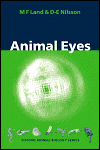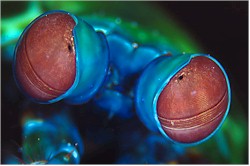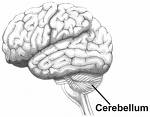
I can pass on "The Natural History of Weasels and Stoats" and also "Western Corn Rootworm," but a few of the other titles featured in the Oxford University Press catalog on Ecology and Evolution titles really look interesting. The most exciting to me is "Animal Eyes."
Back in my grad school days I took a class in stereopsis, the technical term for binocular vision, and chose to write my special project paper on binocular vision in animals other than mammals. Through it I learned that animal eyes are quite diverse, and a few are simply amazing.
We've all heard about the compound eyes of insects - the fancy conglomeration of hundreds of lenses in each eye that form a sort of mosaic tile perception of the world. Those are cool, but they don't provide any binocular depth perception because the lenses of each eye don't coordinate with one another in the organism's brain.
Instead, insects with compound eyes judge distance through monocular cues like texture gradient (finely textured objects are probably nearer), occlusion (if one object blocks another the one that is blocked is farther away), and motion parallax (moving your head from side to side simulates the "camera one," "camera two" effect of binocular vision).

Other animal eyes are way more astounding. Take for instance the mantis shrimp. It has compound eyes but also achieves binocular depth perception within a single eye. Humans, like other animals, need two eyes to have binocular depth perception.
The band that can be seen running horizontally across the mantis shrimp eye separates the two distinct areas above and below. The top and bottom parts of the eye receive different visual inputs (kind of like a right eye vs. left eye), as does the middle band. These areas are coordinated in its brain. Even more amazing is that these three areas are also coordinated with the three matching areas in its other eye, giving it not binocular vision, but hexocular vision.
This animal may have the most complicated eyes on earth. And, that doesn't stop with its perception of depth. This critter also has sophisticated color vision. Whereas humans have trichromatic vision (corresponding to the three different kinds of photoreceptor cells we have in our retinas) that allows us to see light in a relatively narrow range we call the "visual spectrum," the mantis shrimp has four times as many kinds of photoreceptors that allow it to see a much broader spectrum of light, including polarized light.
To find out why these colorful creatures have such complex eyes, check out this entertaining and well-written
NWF article.
Some people, such as those who adhere to the Intelligent Design school of thought, think the existence of such intricate biological systems is evidence of an intelligent designer.
The idea can be traced back to William Paley, a theologist who lived around the time that the pocket watch came into common use, who argued that the existence of god could be inferred from the apparent design of the world. He argued that no one, upon stumbling on a rock in a field, would question how the stone got there. But if we instead found a pocket watch, an object that shows evidence of design in that its individual parts work together to produce motion and can be used to keep time, then we would of course question its existence and infer that it had a maker and that it was produced for a reason.
The ID people look at biological systems this way, and not surprisingly, the eye is one of their favorite subjects.
Proponents of ID cannot accept that parts of an eye would be useful in isolation, however, they are. Eyes evolved in small incremental steps, probably starting with a cell that was sensitive to light, followed by patches of cells sensitive to light, then a lens to concentrate the incoming light on the most light sensitive patch, followed by lenses that could concentrate light more exactly, or more than one lens, and so on. No designer is needed, just random changes in DNA that turn out to be beneficial.
Of course one could always just say that the intelligent designer laid down the rules of physics and chemistry and meiosis and then went on permanent holiday never to be seen or heard from again. Questioning how and why the universe came to be in the first place seems to be a human universal, a sort of species typical trait. Perhaps it's the product of consciousness.
 Yes, say researchers at Caltech. Kenneth Libbrecht, a physicist, has studied the growth of ice crystals in controlled laboratory settings. Ice crystals form around a speck of dust and grow differently depending on the air temperature and humidity. In real life, snowflakes float through the air where temperature and moisture constantly change. Just as no two people have the same developmental history, no two flakes have the same growth history so each is unique.
Yes, say researchers at Caltech. Kenneth Libbrecht, a physicist, has studied the growth of ice crystals in controlled laboratory settings. Ice crystals form around a speck of dust and grow differently depending on the air temperature and humidity. In real life, snowflakes float through the air where temperature and moisture constantly change. Just as no two people have the same developmental history, no two flakes have the same growth history so each is unique. Snowflake, the Albino Gorilla
Snowflake, the Albino Gorilla 










